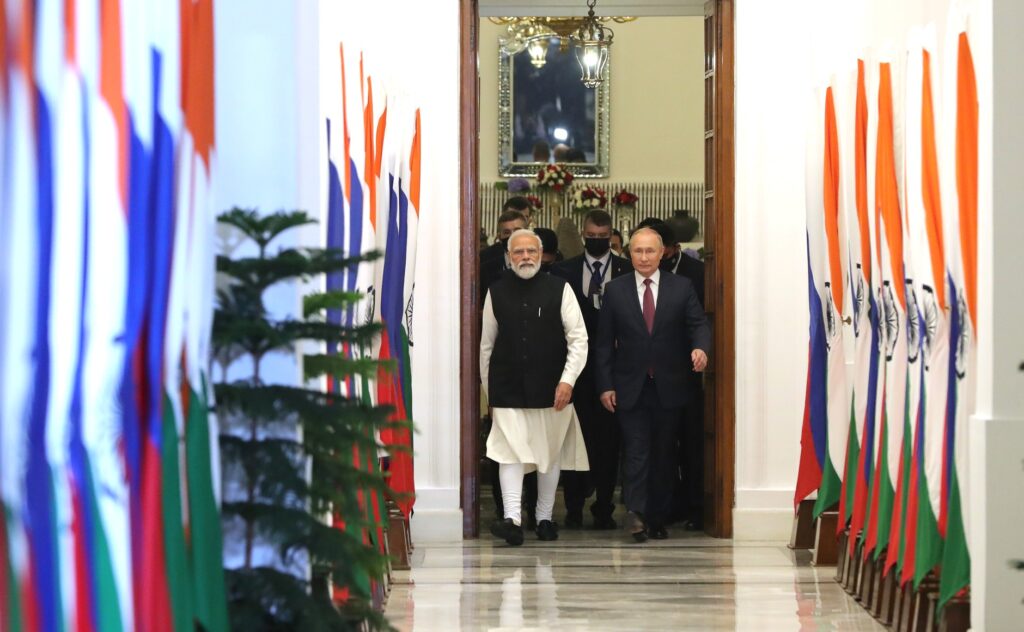By Bea Heard and Rudra Saigal
As relations between the United States and Russia grow hostile amidst the invasion of Ukraine, India is caught between two of its most powerful allies. Long-held historical and military ties with Russia make it a difficult ally to lose. Still, recent economic connections with the West and the geopolitical implications of Russian aggression in Ukraine may push the country to distance itself from a longstanding friend.
India was one of the founders and ardent followers of the non-alignment movement during the start of the Cold War era. However, it was not until 1971 that prevailing geopolitical concerns nudged the country to break away from its historic foreign policy and ally itself more closely with the Soviet Union. As the United States began solidifying its military partnership with India’s archrival, Pakistan, to bolster its own strategic interests in Afghanistan, it further pushed the Indian government to side with the Soviets.
Under President Nixon, U.S. foreign policy aimed to create a breakthrough in diplomatic relations with China — India’s other long-time rival — with Pakistan acting as a friendly mediator. During this time, Sino-American and Pakistani-American ties greatly strengthened.
It was then that India and the Soviet Union realized a common interest in aligning themselves against the threat of a possible Sino-American coalition. This led to the signing of the Treaty of Peace, Friendship, and Cooperation between the two nations in August of 1971. This pact of camaraderie came to test later that year during the third Indo-Pakistani War, which led to the secession of East Pakistan into a new state, Bangladesh. During the war, Pakistan received full military aid and support from the United States, with President Nixon ordering the U.S. 7th Fleet’s Task Force 74, led by the USS Enterprise (a nuclear-armed aircraft carrier), to enter the Bay of Bengal in an effort to intimidate India into a surrender.
President Nixon was also known to have a “personal, irrational dislike” for India’s formidable first-female Prime Minister, Indira Gandhi, exemplified by his ill-thought foreign policy decisions in South Asia. Thus, Gandhi was compelled to turn to her Soviet counterpart, Leonid Brezhnev, for help in case of a possible American intervention. Accepting Gandhi’s request and risking a potential war with the United States, the Soviet Union soon sent its own nuclear-armed naval fleets into the Indian Ocean to deter USS Enterprise from entering the Bay of Bengal, where the Indian navy was carrying out its military operations against East Pakistan.
While Soviet pressure eventually forced Nixon to back down, his blunderous decisions gave rise to massive anti-U.S. sentiments in India. Ever since, New Delhi has found Moscow to be a reliable and trustworthy ally — one that is historically and inextricably tied to India’s defense and foreign policy.
Following the collapse of the Soviet Union and India’s concurrent adoption of economic liberalization in 1991, Indo-American ties have greatly strengthened with changes in U.S. foreign policy post-9/11 further emboldening these ties. Consequently, over the last two decades, trade between the two countries has grown to a whopping $150 billion, while that between India and Russia has stagnated at a mere $8 billion.
Moreover, Indo-American relations have also consolidated in a strategic effort to counter China’s rise. The Quad is the latest manifestation of these efforts, with its focus on promoting ties between nations sharing similar democratic values and ensuring peace, prosperity and openness in the Indo-Pacific.
India — a country with a long history of staying neutral in international crises — risks jeopardizing this increasingly close relationship with the Western world by playing both sides. India remains the only major U.S. ally that has yet to publicly criticize Putin’s actions to the growing frustration of the United States.
Though representatives of the country have put out statements expressing apprehension and concern for the citizens of Ukraine, India remains unwilling to aid in the international effort to place legal pressure on Russia through UN channels. India was one of only 13 countries to abstain on a vote at the UN Human Rights Council in Geneva to set up an international commission of inquiry to investigate Russia’s attack on Ukraine.
This public display of neutrality in such a polarizing and heavily publicized crisis has revealed India’s dependence on a policy of impartiality. India’s inaction lies in stark contrast to the almost entirely unified response from the Western world.
Following suit with Western countries in their response to Russian aggression would mean complying with the sanctions leveled against Russia and outright condemning a country that India has long considered a close ally. The political and economic ramifications of severing ties with Russia affect India in a unique way; not only would India lose a friend, but a large part of their economic and military sectors would be heavily impacted.
The Russian state news agency, Russia Beyond, outlined Indo-Russian relations as a partnership with five key components: diplomacy, counter-terrorism, defense, civil nuclear energy and space. Bilateral trade has also increased between the two countries, with a target goal of $30 billion in trade by 2025.
Defense is India’s key worry amidst pressure to sever ties with Russia. Though recent deals with France and Israel have lowered India’s dependence on Russian military hardware, India still relies on Russia for most of its weaponry. The threat of China at India’s borders means India cannot easily unhitch itself from this reliance on Russian arms without putting itself at a severe military disadvantage.
Another sore point of concern for India is that the war with Ukraine has pushed Russia and China even closer together in the backdrop of heightened Sino-Indian border hostilities. The Indian government has so far managed to not let its strenuous relations with China impact its independent relations with Russia; however, this may prove to be an increasingly difficult challenge for the South Asian nation.
In addition, the Indian public opinion on Russia’s invasion seems to be mixed. There has certainly been some rising pressure on the government to condemn Russia, particularly because Putin’s war put the lives of over 20,000 Indian students studying in Ukraine at risk. In fact, one student was killed by Russian shelling in the city of Kharkiv early on in March, as India struggled to evacuate its citizens safely.
However, at the same time, the memory of Soviet support during the 1971 war continues to serve as a powerful reminder to the Indian people of the threats of American imperialism. For a nation that is still burdened with the nostalgia of its brutal colonial past, its skepticism of Western powers attempting to manipulate its right to pursue its own foreign policy as a sovereign nation is arguably justifiable.
Currently, the Indian government’s policy looks like a careful dance on a tightrope, attempting to keep all sides pleased. So far, it has managed to do a pretty good job. While the Biden administration has expressed its disappointment, it has also fallen short of publicly pressurizing and criticizing India into joining its anti-Russia bandwagon. Naturally, Moscow also seems to be clearly very happy with New Delhi, with the Russian foreign ministry praising India for following a “balanced” approach to the conflict.
How well India is able to continue playing this balancing act, however, remains to be seen.







